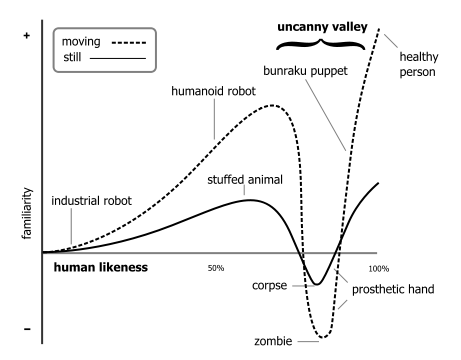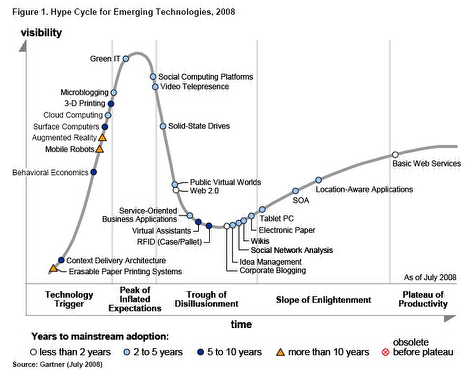Tuesday Topsight, August 26, 2008
Lots of stuff, some of which I hope to get back to in more detail.
• Crowd (Re)Sourcing: Spot.us is a new bottom-up journalism site with a novel funding model: community members pool their money to pay journalists to go after a particular topic. That story then shows up on the Spot.us site, and is pushed to various local media outlets as appropriate.
This isn't a model for breaking-news journalism, but rather for the deeper investigative stuff that blogs tend not to cover so well, and traditional media seems to have largely given up on. Stories underway include the problematic role of ethanol in California (fully-funded), fact-checking San Francisco political claims (almost there), and the connection between SF Bay Area cement kilns and global warming. I'll give you one guess as to where Spot.us is headquartered.
Here's the bigger drawback, though: it's not up yet. There's a blog, and a wiki, and even a Flickr stream of design ideas, but the real site, with real content, won't be up until the Fall.
Worth bookmarking now, though.
• Go North, Young Cow: Cattle, deer, and other grazing animals apparently tend to align themselves along a north-south axis when feeding. And the scientists who reported on this phenomenon, in the Proceedings of the National Academy of Sciences, used Google Earth to do their research.
Dr Sabine Begall, from the University of Duisburg-Essen, Germany, has mainly studied the magnetic sense of mole rats - African animals that live in underground tunnels."We were wondering if larger animals also have this magnetic sense," she told BBC News. [...] The researchers surveyed Google Earth images of 8,510 grazing and resting cattle in 308 pasture plains across the globe.
"Sometimes it took hours and hours to find some pictures with good resolution," said Dr Begall.
The scientists were unable to distinguish between the head and rear of the cattle, but could tell that the animals tended to face either north or south.
Their study ruled out the possibility that the Sun position or wind direction were major influences on the orientation of the cattle.
I'm not sure which is more notable: that cattle have a magnetic sense, or that real scientists writing for a real science journal did their research by looking at Google Earth.
• Blame It On the Oil: Andrew Leonard's How the World Works just posted a compelling new argument as to why the status of women in some Islamic countries remains so abysmal: oil. He quotes UCLA's Michael Ross at length; Ross observes that high oil prices make it cheaper to import goods rather than produce for export, reducing the number of low-end production jobs where women historically first make economic (then political) connections.
Ross (PDF), quoted by Leonard:
Oil production affects gender relations by reducing the presence of women in the labor force. The failure of women to join the nonagricultural labor force has profound social consequences: it leads to higher fertility rates, less education for girls, and less female influence within the family. It also has far-reaching political consequences: when fewer women work outside the home, they are less likely to exchange information and overcome collective action problems; less likely to mobilize politically, and to lobby for expanded rights; and less likely to gain representation in government. This leaves oil-producing states with atypically strong patriarchal cultures and political institutions.
Smart stuff. One of the places it makes me think about, though, is China. Young women moving from the countryside into the cities have over the past couple of decades found work in the big factories assembling consumer goods (that some of the women then move from the factories to the nearby brothels to get a better wage should also be noted). Has the export-driven structure of the Chinese economy led to the development of a stronger civil society, led by women?
• Sharks and Fishes: Over at The Oil Drum, Jeff Vail observes that the pattern of gas prices and oil prices bears a very strong resemblance to classic models of predator-prey population cycles.
It's not intended as anything more than an analogy, but like all good analogies, it serves as a catalyst for new perspectives.
. The importance of this analogy is that it may help us to avoid certain policy mistakes (or at least be aware of them). When the oscillations of price and demand/production are superimposed on top of geological depletion and geopolitical feedback loops, the resulting volatility effectively masks the underlying fundamentals [...]. This presents several problems, each of which may be more avoidable if the medium-term fluctuations in price, production, and demand are seen as oscillations on top of a very worrying underlying trend of peak oil.
I like seeing this kind of analysis, simply because it's exactly the kind of work that tends to kick-start new ideas.
• The Uncanny Hype Cycle:
What does this chart:

...have to do with this chart:
(Click image for larger version)
Nothing, ostensibly, but I couldn't help but notice a real similarity in form between the Hype Cycle and the Uncanny Valley. They're not identical, of course; for one thing, in the Gardner "Hype Cycle," technology is somehow more visible when it's still in development (but talked about) than when it's actually in mainstream use. Still, it's something that makes me go hmm.
• Safer Orbital Mechanics: Finally, how do you deal with a problem like a possible asteroid strike? Wrap it for safety. That's the proposal of Australian engineering student Mary D'Souza for preventing a kinetic unpleasantness with asteroid Apophis, now scheduled for a close-approach in 2029 and potentially giving the Earth a good whack in 2036. She argues that wrapping the 270-meter asteroid with a reflective sheet (like Mylar) would make it so that reflected sunlight changes its orbit ever-so-slightly. Do something like this early enough, and an ever-so-slight shift is enough to make the asteroid miss us by quite a bit.
Works for me.







Comments
Happy to talk more about Spot.Us - we are working hard to get the site up and running asap.
In the meantime - join our facebook group or subscribe to the blog to see how it all comes together.
best
David Cohn
Posted by: Digidave | August 26, 2008 4:19 PM
Re Cows: I wonder if they allowed for the pixel alignment on the CCD taking the pictures? It is possible small objects are easier to resolve when they happen to align vertically on the CCD?
Re Oil: It seems likely the oil countries will go directly from a commodity provider to a service economy without any noticeable manufacturing period inbetween. I am not sure what that will do for the eventual outcome but it will likely be different.
Posted by: John B Stone | August 27, 2008 10:30 AM
The hype cycle might a little more interesting if the history of each technology could be incorporated. (I suppose the symbols estimating time to mainstream adoption is a start)
re: cows. If it were a pixel alignment artefact, I would have thought you'd get as many east-west alignments. Besides, I doubt the cameras were actually oriented north at the time the picture was taken
Posted by: Tony Fisk | August 27, 2008 5:21 PM
Hey man you are definitely right about the hype cycle and I simply loved the post because I have never seen someone explaining in so much detail
Posted by: Robin | November 23, 2008 7:32 AM